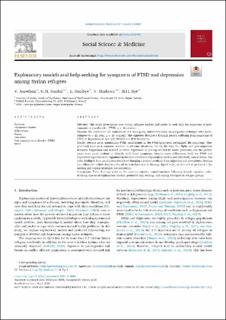| dc.contributor.author | Aarethun, Vilde | |
| dc.contributor.author | Sandal, Gro Mjeldheim | |
| dc.contributor.author | Guribye, Eugene | |
| dc.contributor.author | Markova, Valeria | |
| dc.contributor.author | Bye, Hege Høivik | |
| dc.date.accessioned | 2022-02-01T07:30:07Z | |
| dc.date.available | 2022-02-01T07:30:07Z | |
| dc.date.created | 2021-04-05T14:48:28Z | |
| dc.date.issued | 2021 | |
| dc.identifier.issn | 0277-9536 | |
| dc.identifier.uri | https://hdl.handle.net/11250/2976149 | |
| dc.description.abstract | Objective This study investigates how Syrian refugees explain and prefer to seek help for symptoms of post-traumatic stress disorder (PTSD) and depression. Methods We conducted five semi-structured focus group interviews based on a vignette-technique with Syrian refugees (n = 21 men, n = 10 women). The vignettes describe a fictional person suffering from symptoms of PTSD or depression in line with DSM-5 and ICD-10 criteria. Results Despite never mentioning PTSD, participants in the PTSD-interviews recognized the symptoms. They perceived them as a common reaction to extreme situations, mainly the war, the flight, and post-migratory stressors. Depression was labeled as either depression or feelings caused by social problems, and the participants were more hesitant to identify with these symptoms. Despite some differences, both the PTSD and depression vignettes were explained in terms of situational explanatory models and externally caused stress. The main finding is how participants described changing stressors resulting from migration and resettlement leading to a difference in how they would seek help in Syria and in Norway. Specifically, we found that preferred help-seeking and coping strategies are contextual. Conclusions These findings point to the need to consider transformations following forced migration when studying aspects of explanatory models, preferred help-seeking, and coping strategies in refugee groups. | en_US |
| dc.language.iso | eng | en_US |
| dc.rights | Navngivelse 4.0 Internasjonal | * |
| dc.rights.uri | http://creativecommons.org/licenses/by/4.0/deed.no | * |
| dc.title | Explanatory models and help-seeking for symptoms of PTSD and depression among Syrian refugees | en_US |
| dc.type | Peer reviewed | en_US |
| dc.type | Journal article | en_US |
| dc.rights.holder | The authors | en_US |
| dc.description.version | publishedVersion | en_US |
| cristin.ispublished | true | |
| cristin.fulltext | original | |
| cristin.qualitycode | 2 | |
| dc.identifier.doi | 10.1016/j.socscimed.2021.113889 | |
| dc.identifier.cristin | 1902115 | |
| dc.source.journal | Social Science and Medicine | en_US |
| dc.source.volume | 277 | en_US |
| dc.relation.project | Norges forskningsråd: 273645 | en_US |

